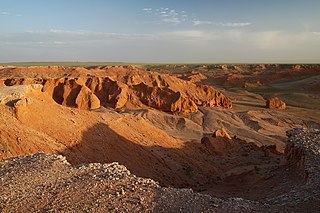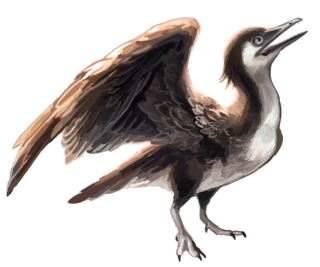
Shuvuuia is a genus of bird-like theropod dinosaur from the late Cretaceous period of Mongolia. It is a member of the family Alvarezsauridae, small coelurosaurian dinosaurs which are characterized by short but powerful forelimbs specialized for digging. The type species is Shuvuuia deserti, or "desert bird". The name Shuvuuia is derived from the Mongolian word shuvuu (шувуу) meaning "bird".

Alvarezsauridae is a family of small, long-legged dinosaurs. Although originally thought to represent the earliest known flightless birds, they are now thought to be an early diverging branch of maniraptoran theropods. Alvarezsaurids were highly specialized. They had tiny but stout forelimbs, with compact, bird-like hands. Their skeletons suggest that they had massive breast and arm muscles, possibly adapted for digging or tearing. They had long, tube-shaped snouts filled with tiny teeth. They have been interpreted as myrmecophagous, adapted to prey on colonial insects such as termites, with the short arms acting as effective digging instruments to break into nests.

The Enantiornithes, also known as enantiornithines or enantiornitheans in literature, are a group of extinct avialans, the most abundant and diverse group known from the Mesozoic era. Almost all retained teeth and clawed fingers on each wing, but otherwise looked much like modern birds externally. Over eighty species of Enantiornithes have been named, but some names represent only single bones, so it is likely that not all are valid. The Enantiornithes became extinct at the Cretaceous–Paleogene boundary, along with Hesperornithes and all other non-avian dinosaurs.

Avimimus, meaning "bird mimic", is a genus of oviraptorosaurian theropod dinosaur, named for its bird-like characteristics, that lived in the late Cretaceous in what is now Mongolia, around 85 to 70 million years ago.

Rahonavis is a genus of bird-like theropods from the Late Cretaceous of what is now northwestern Madagascar. It is known from a partial skeleton found by Catherine Forster and colleagues in Maevarano Formation rocks at a quarry near Berivotra, Mahajanga Province. Rahonavis was a small predator, at about 70 centimetres (2.3 ft) long and 0.45-2.27 kg, with the typical dromaesaurid-like raised sickle claw on the second toe. It was originally the first African coelurosaur until the discovery of Nqwebasaurus in 2000.

Bagaceratops is a genus of small protoceratopsid dinosaurs that lived in Asia during the Late Cretaceous, around 72 to 71 million years ago. Bagaceratops remains have been reported from the Barun Goyot Formation and Bayan Mandahu Formation. One specimen may argue the possible presence of Bagaceratops in the Djadochta Formation.

Mononykus is a genus of alvarezsaurid dinosaur that lived during the Late Cretaceous in what is now Asia on the Nemegt Formation, about 70 million years ago.
Kuru is a genus of dromaeosaurid theropod from the Late Cretaceous Barun Goyot Formation of Mongolia. The genus contains only a single species, the type species Kuru kulla, which is known from a fragmentary skeleton including a partial skull.

Citipati is a genus of oviraptorid dinosaur that lived in Asia during the Late Cretaceous period, about 75 million to 71 million years ago. It is mainly known from the Ukhaa Tolgod locality at the Djadochta Formation, where the first remains were collected during the 1990s. The genus and type species Citipati osmolskae were named and described in 2001. A second species from the adjacent Zamyn Khondt locality may also exist. Citipati is one of the best-known oviraptorids thanks to a number of well-preserved specimens, including individuals found in brooding positions atop nests of eggs, though most of them were initially referred to the related Oviraptor. These nesting specimens have helped to solidify the link between non-avian dinosaurs and birds.

The Barun Goyot Formation is a geological formation dating to the Late Cretaceous Period. It is located within and is widely represented in the Gobi Desert Basin, in the Ömnögovi Province of Mongolia.

The Nemegt Formation is a geological formation in the Gobi Desert of Mongolia, dating to the Late Cretaceous. The formation consists of river channel sediments and contains fossils of fish, turtles, crocodilians, and a diverse fauna of dinosaurs, including birds.

The Djadochta Formation is a highly fossiliferous geological formation situated in Central Asia, Gobi Desert, dating from the Late Cretaceous period, about 75 million to 71 million years ago. The type locality is the Bayn Dzak locality, famously known as the Flaming Cliffs. Reptile and mammal remains are among the fossils recovered from the formation.
Ambiortus is a prehistoric bird genus. The only known species, Ambiortus dementjevi, lived sometime during the Barremian age between 136.4 and 125 million years ago in the Andaikhudag Formation of Mongolia. It was discovered by Yevgeny Kurochkin in 1982.

Ceratonykus is a monospecific genus of alvarezsaurid dinosaur from Mongolia that lived during the Late Cretaceous in what is now the Barun Goyot Formation. The type and only species, Ceratonykus oculatus, is known from a fragmentary skeleton, including an incomplete skull, of an adult individual. It was named and described in 2009 by Vladimir Alifanov and Rinchen Barsbold. Its describers questioned the traditional placement of alvarezsaurs in Theropoda, instead suggesting they were ornithischians, but this has not been accepted since. Ceratonykus has an estimated length of 75 centimetres and weight of 760 grams. It has been considered as a possible junior synonym of Parvicursor.

Songlingornithidae is a family of basal euornithean dinosaurs from the Early Cretaceous of China. All known specimens come from the Jiufotang Formation and the Yixian Formation, dating to the early Barremian and Aptian ages, 125–120 million years ago.

Yanornithiformes is an order of ornithuromorph birds from the early Cretaceous Period of China. All known specimens come from the Yixian Formation and Jiufotang Formation, dating to the early Aptian age, 124.6 to 120 million years ago.
Ambiortiformes is a group of prehistoric ornithuromorphs.

Luis María Chiappe is an Argentine paleontologist born in Buenos Aires who is best known for his discovery of the first sauropod nesting sites in the badlands of Patagonia in 1997 and for his work on the origin and early evolution of Mesozoic birds. He is currently the Vice President of Research and Collections at the Natural History Museum of Los Angeles County and director of the museum's Dinosaur Institute. He was a postdoctoral researcher at the American Museum of Natural History, New York after immigrating from Argentina. Chiappe is currently the curator of the award winning Dinosaur Hall at the Natural History Museum of Los Angeles County, an adjunct professor at the University of Southern California, BBC advisor and author of scientific and popular books.

Natovenator is a genus of halszkaraptorine dromaeosaurid dinosaur from the Late Cretaceous Barun Goyot Formation of Mongolia. The genus is known from a single species, N. polydontus. Natovenator is crucial to the understanding of halszkaraptorines due to it providing more support for the semi-aquatic lifestyle that has been proposed for this clade. This discovery is important as the semi-aquatic lifestyles of halszkaraptorines was contested in early 2022.


























